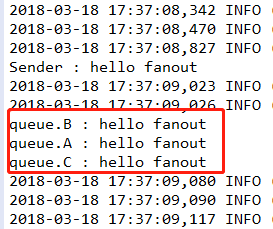21.Spring-Boot中RabbitMQ使用
注意:默认账号guest具有所有操作的权限,并且出于安全的考虑,guest用户只能通过localhost登录使用,如果想通过远程ip连接,需要重庆创建新的用户。
模式使用的就是direct交换器模式
一:Direct交换器使用
1.配置pom包,主要是添加spring-boot-starter-amqp的支持
org.springframework.boot
spring-boot-starter-amqp
2.在application.properties中配置rabbit连接参数
spring.rabbitmq.host=11.12.112.159
spring.rabbitmq.port=5672
spring.rabbitmq.username=admin
spring.rabbitmq.password=1234563.队列交换器配置
package com.niugang;
import org.springframework.context.annotation.Bean;
import org.springframework.context.annotation.Configuration;
import org.springframework.amqp.core.Binding;
import org.springframework.amqp.core.BindingBuilder;
import org.springframework.amqp.core.DirectExchange;
import org.springframework.amqp.core.Queue;
@Configuration
public class RabbitDirectConfig {
//创建队列
@Bean
public Queue queue() {
// 创建一个队列路由键为hello
return new Queue("hello");
}
//创建交换器
@Bean
public DirectExchange directExchange() {
return new DirectExchange("direct-exchange");
}
//绑定交换器和路由键
@Bean
public Binding bindingExchange() {
return BindingBuilder.bind(queue()).to(directExchange()).with("hello");
}
}4.创建消息生成者(发送者)
package com.niugang.mq.send;
import org.springframework.amqp.core.AmqpTemplate;
import org.springframework.beans.factory.annotation.Autowired;
import org.springframework.stereotype.Component;
@Component
public class HelloSender {
@Autowired
private AmqpTemplate rabbitTemplate;
public void send(String context) {
System.out.println("Sender : " + context);
//通过源码默认的交换器模式为direct
//绑定路由键hello
this.rabbitTemplate.convertAndSend("direct-exchange","hello", context);
}
}5.创建消费者(接收者)
接收者1
package com.niugang.mq.receiver;
import org.springframework.amqp.rabbit.annotation.RabbitHandler;
import org.springframework.amqp.rabbit.annotation.RabbitListener;
import org.springframework.stereotype.Component;
@Component
//@RabbitListener监听具体的队列或绑定
@RabbitListener(queues = "hello")
public class HelloReceiver1 {
@RabbitHandler
public void process(String hello) {
System.out.println("Receiver1 : " + hello);
}
}
接收者2
package com.niugang.mq.receiver;
import org.springframework.amqp.rabbit.annotation.RabbitHandler;
import org.springframework.amqp.rabbit.annotation.RabbitListener;
import org.springframework.stereotype.Component;
@Component
//@RabbitListener监听具体的队列或绑定
@RabbitListener(queues = "hello")
public class HelloReceiver2 {
@RabbitHandler
public void process(String hello) {
System.out.println("Receiver2 : " + hello);
}
}
6.测试
package com.niugang.test;
import org.junit.Test;
import org.junit.runner.RunWith;
import org.springframework.beans.factory.annotation.Autowired;
import org.springframework.boot.test.context.SpringBootTest;
import org.springframework.test.context.junit4.SpringRunner;
import com.niugang.mq.send.HelloSender;
@RunWith(SpringRunner.class)
@SpringBootTest
public class RabbitTest {
@Autowired
private HelloSender helloSender;
@Test
public void hello() throws Exception {
for (int i = 0; i <= 10; i++) {
helloSender.send("hello"+i);
Thread.sleep(500);
}
}
}7.运行结果
对于Direct模式的交换器,当队列拥有多个消费者时,队列收到的消息将以循环的方式发送给消费者。每条消息只能发送给一个订阅的消费者。
二:Fanout交换器的使用
1.2步同上
3.配置交换器和队列
package com.niugang;
import org.springframework.context.annotation.Bean;
import org.springframework.context.annotation.Configuration;
import org.springframework.amqp.core.Binding;
import org.springframework.amqp.core.BindingBuilder;
import org.springframework.amqp.core.FanoutExchange;
import org.springframework.amqp.core.Queue;
@Configuration
public class RabbitFanoutConfig {
//创建队列
@Bean
public Queue queueA() {
return new Queue("queue.A");
}
@Bean
public Queue queueB() {
return new Queue("queue.B");
}
@Bean
public Queue queueC() {
return new Queue("queue.C");
}
//创建交换器
@Bean
public FanoutExchange fanoutExchange() {
return new FanoutExchange("fanout-exchange");
}
//绑定交换器和路由键
@Bean
public Binding bindingExchangeA() {
return BindingBuilder.bind(queueA()).to(fanoutExchange());
}
@Bean
public Binding bindingExchangeB() {
return BindingBuilder.bind(queueB()).to(fanoutExchange());
}
@Bean
public Binding bindingExchangeC() {
return BindingBuilder.bind(queueC()).to(fanoutExchange());
}
}
4.创建消息生成者(发送者)
package com.niugang.mq.send;
import org.springframework.amqp.core.AmqpTemplate;
import org.springframework.beans.factory.annotation.Autowired;
import org.springframework.stereotype.Component;
@Component
public class FanoutSender {
@Autowired
private AmqpTemplate rabbitTemplate;
public void send(String context) {
System.out.println("Sender : " + context);
//因为fanout交换器模式是广播消息,所系这块队列只需要给个空字符串
this.rabbitTemplate.convertAndSend("fanout-exchange","", context);
}
}5.创建消费者(接收者)
消费者A:
package com.niugang.mq.receiver;
import org.springframework.amqp.rabbit.annotation.RabbitHandler;
import org.springframework.amqp.rabbit.annotation.RabbitListener;
import org.springframework.stereotype.Component;
@Component
//@RabbitListener监听具体的队列或绑定
@RabbitListener(queues = "queue.A")
public class FanoutReceiverA {
@RabbitHandler
public void process(String hello) {
System.out.println("queue.A : " + hello);
}
}消费者B:
package com.niugang.mq.receiver;
import org.springframework.amqp.rabbit.annotation.RabbitHandler;
import org.springframework.amqp.rabbit.annotation.RabbitListener;
import org.springframework.stereotype.Component;
@Component
//@RabbitListener监听具体的队列或绑定
@RabbitListener(queues = "queue.B")
public class FanoutReceiverB {
@RabbitHandler
public void process(String hello) {
System.out.println("queue.B : " + hello);
}
}消费者C:
package com.niugang.mq.receiver;
import org.springframework.amqp.rabbit.annotation.RabbitHandler;
import org.springframework.amqp.rabbit.annotation.RabbitListener;
import org.springframework.stereotype.Component;
@Component
//@RabbitListener监听具体的队列或绑定
@RabbitListener(queues = "queue.C")
public class FanoutReceiverC {
@RabbitHandler
public void process(String hello) {
System.out.println("queue.C : " + hello);
}
}6..测试
package com.niugang.test;
import org.junit.Test;
import org.junit.runner.RunWith;
import org.springframework.beans.factory.annotation.Autowired;
import org.springframework.boot.test.context.SpringBootTest;
import org.springframework.test.context.junit4.SpringRunner;
import com.niugang.mq.send.FanoutSender;
@RunWith(SpringRunner.class)
@SpringBootTest
public class RabbitTest {
@Autowired
private FanoutSender fanoutSender;
@Test
public void send() throws Exception {
fanoutSender.send("hello fanout");
}
}7.运行结果
结果1
结果2
从运行结果来看,fanout交换器广播消息的顺序是随机的。
微信公众号 ![]()


